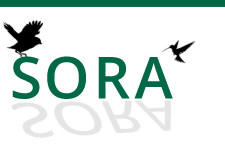A New Breeding Record for California
Online Full Text
May 14, 1916, at Crescent City, Del Norte County, California, was a beautiful, bright, calm day. The panoramic view of that crescent stretch of sand, bordered by the Pacific in one of its calmest moods, with Whaler Island blending into its own shadow but a mile away, made irresistable the desire to seek out some new wonder. A skiff riding at anchor nearby was soon bargained for, and that mile to Whaler Island shortened its distance like magic. A landing was made on the rough rocks at the eastern end, nearest the shore.
A hurried inspection of the surroundings disclosed numerous holes in the ground on the central part of the island and promising crags on the west slope, overlooking the sea. Among the boulders I crawled, peeking in under this one and feeling in under that one. Bending way over, eyes strained, trying to pierce the darkness of a deep crevice, a blue object could barely be seen sticking from under a large wedge-shaped boulder, that barely left room for the hand; it was not the dark tail and white rump of which I was so familiar. A new wonder was disclosed-a beautiful male Fork-tailed Petrel (Oceanodroma furcata) which subsequently became skin number 453, with wellincubated egg number 2-16/l-the basis of a new breeding record for the State of California. Not a lone pair of Fork-tailed, but a colony of approximately 100 pairs, was nesting on the west end. The honeycomb-like holes on the grassy flats were homes of the Kaeding Petrels, probably 300 pairs nesting there.
Lo and behold, seventy miles farther south, on Sugar Loaf Rock at Trinidad, a still farther southward breeding record for furcata. In company with Mr. W. Leon Dawson on June 18, 1916, I visited the rocks off the Humboldt coast. Mr. Dawson, lucky fellow, pulled, tail first, from a Tufted Puffins’ burrow a Fork-tailed Petrel and, I might add, later a fresh egg of the same bird. I discovered a young Fork-tailed Petrel in the downy state the same day, and, several days after, Mr. Dawson took one adult and two young from the same island. The Fork-tailed were nesting in the sandy ground (unusual for this species) among about thirty pairs of the Kaeding Petrel.
Eureka, California, July 24, 191
Creative Commons License
Recommended Citation
Clay, C. I.
(1916)
"A New Breeding Record for California,"
Condor: Vol. 18
:
Iss.
5
, Article 20.
Available at:
https://digitalcommons.usf.edu/condor/vol18/iss5/20

